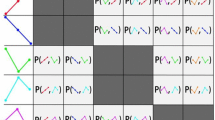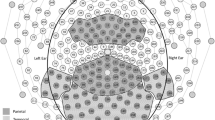Abstract
Recent achievements in evaluating the residual consciousness of patients with disorders of consciousness (DOCs) have demonstrated that spontaneous or evoked electroencephalography (EEG) could be used to improve consciousness state diagnostic classification. Recent studies showed that the EEG signal of the task-state could better characterize the conscious state and cognitive ability of the brain, but it has rarely been used in consciousness assessment. A cue-guide motor task experiment was designed, and task-state EEG were collected from 18 patients with unresponsive wakefulness syndrome (UWS), 29 patients in a minimally conscious state (MCS), and 19 healthy controls. To obtain the markers of residual motor function in patients with DOC, the event-related potential (ERP), scalp topography, and time–frequency maps were analyzed. Then the coherence (COH) and debiased weighted phase lag index (dwPLI) networks in the delta, theta, alpha, beta, and gamma bands were constructed, and the correlations of network properties and JFK Coma Recovery Scale-Revised (CRS-R) motor function scores were calculated. The results showed that there was an obvious readiness potential (RP) at the Cz position during the motor preparation process in the MCS group, but no RP was observed in the UWS group. Moreover, the node degree properties of the COH network in the theta and alpha bands and the global efficiency properties of the dwPLI network in the theta band were significantly greater in the MCS group compared to the UWS group. The above network properties and CRS-R motor function scores showed a strong linear correlation. These findings demonstrated that the brain network properties of task-state EEG could be markers of residual motor function of DOC patients.





Similar content being viewed by others
Data availability
The raw EEG data can be acquired by contacting the corresponding author.
References
Bai Y, **a X, Li X (2017a) A review of resting-state electroencephalography analysis in disorders of consciousness. Front Neurol 8:471
Bai Y, **a X, Kang J et al (2017b) TDCS modulates cortical excitability in patients with disorders of consciousness. Neuroimage Clin 15:702–709
Bai Y, Lin Y, Ziemann U (2020) Managing disorders of consciousness: the role of electroencephalography. J Neurol 268(11):4033–4065
Benjamini Y, Hochberg Y (1995) Controlling the false discovery rate: a practical and powerful approach to multiple testing. J Roy Stat Soc Ser B (methodol) 57(1):289–300
Bodart O, Gosseries O, Wannez S et al (2017) Measures of metabolism and complexity in the brain of patients with disorders of consciousness. Neuroimage Clin 14:354–362
Cruse D, Chennu S, Chatelle C et al (2011) Bedside detection of awareness in the vegetative state: a cohort study. Lancet 378(9809):2088–2094
Delorme A, Makeig S (2004) Eeglab: an open source toolbox for analysis of single-trial EEG dynamics including independent component analysis. J Neurosci Methods 134(1):9–21
di Russo F, Berchicci M, Bozzacchi C et al (2017) Beyond the “Bereitschaftspotential”: action preparation behind cognitive functions. Neurosci Biobehav Rev 78:57–81
Giacino JI, Ashwal S, Childs N et al (2002) The minimally conscious state: definition and diagnostic criteria - Reply. Neurology 59(9):1473–1474
Giacino JT, Kalmar K, Whyte J (2004) The JFK coma recovery scale-revised: measurement characteristics and diagnostic utility. Arch Phys Med Rehab 85(12):2020–2029
Giacino JT, Fins JJ, Laureys S et al (2014) Disorders of consciousness after acquired brain injury: the state of the science. Nat Rev Neurol 10(2):99–114
Gui P, Jiang Y, Zang D et al (2020) Assessing the depth of language processing in patients with disorders of consciousness. Nat Neurosci 23(6):761–770
Hu Y, Zhang L, Chen M et al (2017) How electroencephalogram reference influences the movement readiness potential? Front Neurosci 11:683
Jung TP, Makeig S, Westerfield M et al (2000) Removal of eye activity artifacts from visual event-related potentials in normal and clinical subjects. Clin Neurophysiol 111(10):1745–1758
Klimkeit EI, Mattingley JB, Sheppard DM et al (2005) Motor preparation, motor execution, attention, and executive functions in attention deficit/hyperactivity disorder (ADHD). Child Neuropsychol 11(2):153–173
Kornhuber HH, Deecke L (1965) Changes in the brain potential in voluntary movements and passive movements in man: readiness potential and reafferent potentials. Pflugers Arch Gesamte Physiol Menschen Tiere 284(6):1–17
Latora V, Marchiori M (2001) Efficient behavior of small-world networks. Phys Rev Lett 87(19):198701
Laureys S, Celesia GG, Cohadon F et al (2010) Unresponsive wakefulness syndrome: a new name for the vegetative state or apallic syndrome. Bmc Med. https://doi.org/10.1186/1741-7015-8-68
Li R, Song WQ, Du JB et al (2015) Connecting the P300 to the diagnosis and prognosis of unconscious patients. Neural Regen Res 10(3):473–480
Liu TJ, Li FL, Jiang Y et al (2017) cortical dynamic causality network for auditory-motor tasks. IEEE Trans Neural Sys Rehabil Eng 25(8):1092–1099
Malagurski B, Peran P, Sarton B et al (2019) Topological disintegration of resting state functional connectomes in coma. Neuroimage 195:354–361
Mohseni M, Shalchyan V, Jochumsen M et al (2020) Upper limb complex movements decoding from pre-movement EEG signals using wavelet common spatial patterns. Comput Methods Progr Biomed 183:105076
Mouthon AL, van Hedel HJA, Meyer-Heim A et al (2016) High-density electroencephalographic recordings during sleep in children with disorders of consciousness. Neuroimage Clin 11:468–475
Naro A, Bramanti P, Leo A et al (2016) Transcranial alternating current stimulation in patients with chronic disorder of consciousness: a possible way to cut the diagnostic Gordian knot? Brain Topogr 29(4):623–644
Naro A, Bramanti A, Leo A et al (2018) Shedding new light on disorders of consciousness diagnosis: the dynamic functional connectivity. Cortex 103:316–328
Nguyen VT, Breakspear M, Cunnington R (2014) Reciprocal interactions of the SMA and cingulate cortex sustain premovement activity for voluntary actions. J Neurosci 34(49):16397–16407
Oostenveld R, Fries P, Maris E et al (2011) FieldTrip: open source software for advanced analysis of MEG, EEG, and invasive electrophysiological data. Comput Intell Neurosci 2011:156869
Pan J, **e Q, Qin P et al (2020) Prognosis for patients with cognitive motor dissociation identified by brain-computer interface. Brain 143(4):1177–1189
Peraza LR, Aziz URA, Gary G et al (2012) Volume conduction effects in brain network inference from electroencephalographic recordings using phase lag index. J Neurosci Methods 207(2):189–199
Pereda E, Quiroga RQ, Bhattacharya J (2005) Nonlinear multivariate analysis of neurophysiological signals. Prog Neurobiol 77(1–2):1–37
Pfurtscheller G, da Silva FHL (1999) Event-related EEG/MEG synchronization and desynchronization: basic principles. Clin Neurophysiol 110(11):1842–1857
Ragazzoni A, Pirulli C, Veniero D et al (2013) Vegetative versus minimally conscious states: a study using TMS-EEG, sensory and event-related potentials. PLoS ONE 8(2):e57069
Risetti M, Formisano R, Toppi J et al (2013) On ERPs detection in disorders of consciousness rehabilitation [J]. Front Human Neurosci. https://doi.org/10.3389/fnhum.2013.00775
Rohaut B, Faugeras F, Chausson N et al (2015) Probing ERP correlates of verbal semantic processing in patients with impaired consciousness. Neuropsychologia 66:279–292
Rossi Sebastiano D, Visani E, Panzica F et al (2018) Sleep patterns associated with the severity of impairment in a large cohort of patients with chronic disorders of consciousness. Clin Neurophysiol 129(3):687–693
Rubinov M, Sporns O (2010) Complex network measures of brain connectivity: uses and interpretations. Neuroimage 52(3):1059–1069
Schiff ND, Plum F (2000) The role of arousal and “gating” systems in the neurology of impaired consciousness. J Clin Neurophysiol 17(5):438–452
Schmidt S, Jo HG, Wittmann M et al (2016) “Catching the waves” - slow cortical potentials as moderator of voluntary action. Neurosci Biobehav R 68:639–650
Schnakers C, Vanhaudenhuyse A, Giacino J et al (2009) Diagnostic accuracy of the vegetative and minimally conscious state: clinical consensus versus standardized neurobehavioral assessment. BMC Neurol. https://doi.org/10.1186/1471-2377-9-35
Schurger A, Hu P, X, et al (2021) What is the readiness potential? Trends Cognit Sci 25(7):558–570
Shibasaki H, Hallett M (2006) What is the Bereitschaftspotential? Clin Neurophysiol 117(11):2341–2356
Stefan S, Schorr B, Lopez-Rolon A et al (2018) Consciousness indexing and outcome prediction with resting-state EEG in severe disorders of consciousness. Brain Topogr 31(5):848–862
Vinck M, Oostenveld R, van Wingerden M et al (2011) An improved index of phase-synchronization for electrophysiological data in the presence of volume-conduction, noise and sample-size bias. Neuroimage 55(4):1548–1565
Wang K, Xu M, Wang Y et al (2020) Enhance decoding of pre-movement EEG patterns for brain-computer interfaces. J Neural Eng 17(1):016033
Wislowska M, Del Giudice R, Lechinger J et al (2017) Night and day variations of sleep in patients with disorders of consciousness. Sci Rep 7(1):266
Wisniewski D, Goschke T, Haynes JD (2016) Similar coding of freely chosen and externally cued intentions in a fronto-parietal network. Neuroimage 134:450–458
Yao DZ (2001) A method to standardize a reference of scalp EEG recordings to a point at infinity [J]. Physiol Meas 22(4):693–711
Zhang L, Wang P, Zhang R et al (2020) The influence of different EEG references on scalp EEG functional network analysis during hand movement tasks. Front Hum Neurosci 14:367
Acknowledgements
This research was supported by the Technology Project of Henan Province (No. 202102310210); the Key Project of Discipline Construction of Zhengzhou University (No. XKZDQY201905); the Chinese National Natural Science Foundation (No. 82001112); the Medical science and Technology research project of Henan Province (No. LHGJ20190409); the National Key R&D Program of China (2020YFC2006100) and the National Natural Science Foundation of China (No. 61803342). We thank LetPub (www.letpub.com) for its linguistic assistance during the preparation of this manuscript.
Author information
Authors and Affiliations
Corresponding author
Ethics declarations
Conflict of interest
The authors declare that they have no conflict of interest. Written, informed consent was obtained from the patients for the publication of any potentially identifiable data included in this article.
Additional information
Publisher's Note
Springer Nature remains neutral with regard to jurisdictional claims in published maps and institutional affiliations.
Supplementary Information
Below is the link to the electronic supplementary material.
Rights and permissions
About this article
Cite this article
Zhang, L., Zhang, R., Guo, Y. et al. Assessing residual motor function in patients with disorders of consciousness by brain network properties of task-state EEG. Cogn Neurodyn 16, 609–620 (2022). https://doi.org/10.1007/s11571-021-09741-7
Received:
Revised:
Accepted:
Published:
Issue Date:
DOI: https://doi.org/10.1007/s11571-021-09741-7




